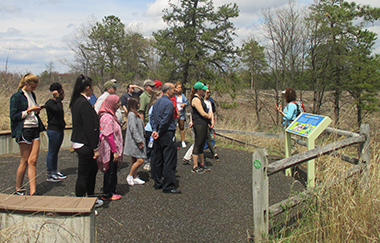Re-Enlivening the Urban Core
 |
|
Students and researchers take time out from the Land Use and Sustainability Symposium to take a hike into the Albany Pine Bush. |
ALBANY, N.Y. (May 24, 2018) — Upstate New York has been experiencing suburbanization forces for many decades, with profound implications for many of the more traditional neighborhoods in Albany, Troy and Schenectady, among others. The subject brought a group of scholars, practitioners, students and community members to the Albany Pine Bush Preserve on May 4, focused on land use planning and sustainable development.
The all-day Land Use and Sustainability Symposium covered several scholarly themes beyond its title, said Assistant Professor Carlos Balsas of Geography & Planning, who co-organized the event with Professor Keith Hirokawa of Albany Law School: “From landscape ecology and landscape assessment and valuation, to green infrastructure, environmental planning law, sense of place, social media and sustainability, cognitive architecture, campus planning, clean energy and climate change.”
The result? “Participants gained the necessary theoretical backing to help implement more sustainable urban development practices in the Capital Region and beyond,” said Balsas. “They rediscovered new land use planning ideas, concepts and tools ranging from sustainable urbanism to biophilia, cognitive architecture, behavioral ecology and green infrastructure, among others.”
Featured speakers from the region included UAlbany Professor Mathias Vuille of Atmospheric and Environmental Sciences, Mary Ellen Mallia, UAlbany’s director of Environmental Sustainability, sociologist Rik Scarce of Skidmore, Todd Fabozzi of the Capital District Regional Planning Commission and Neil Gifford of the Pine Bush Preserve. Also contributing were environmental scientists, landscape architects and urban and regional planners from SUNY’s College of Environmental Science and Forestry, the University of Massachusetts and Tufts University.
The symposium included formal talks in the morning, informal networking, a guided tour and hike of one of the preserve’s trails, and an afternoon roundtable discussion. The group also screened portions of Scarce’s 2015 documentary of the Hudson River region, "Sustaining this Place."
Suburbanization was a major theme. “New growth areas along I-87, Route 5, Route 9 and Route 20, have propelled development in places like Clifton Park, Saratoga Springs and Guilderland; on the other hand, relatively semi-rural living conditions in East Greenbush, Guilderland and Voorheesville, for instance, keep enticing people away from the older and more mature urban cores of Troy, Rensselaer and Albany,” said Balsas.
Well known is that many employees commute from suburban homes to such central Albany locations as the Empire State Plaza and the Harriman State Campus, as well as major employment establishments on Central Avenue and Colonie’s Wolf Road — “without,” notes Balsas, “interacting much with the various communities in the core of the metropolis.
“Rush hour commuting causes debilitating congestion and a progressive abandonment of the more central areas of the metropolis,” he added. “On the other hand, older cores have been experiencing prolonged abandonment and some urban blight. Certain inner-city neighborhoods tend to be occupied mostly by ethnic minorities without the necessary resources to fully support the much-needed public services.
“These problems involve not only land use and transportation decisions but also business priorities, local planning decisions, and attempts at creating ideal notions of community. Furthermore, and quite often, they result not only from an inappropriate supply of housing, equipment, infrastructure and schools, but they also involve cultural and family preferences and lifestyle decisions.
Balsas said the symposium’s participants look forward to continuing their discussions as well as to conducting research leading to a better understanding of land use and sustainability matters in the Capital Region.
Symposium funding came from the UAlbany-Albany Law Collaboration Seminar and Conference Fund, with additional co-sponsorship from Geography & Planning, the College of Arts and Sciences, the Office of the Vice President for Research, and the Albany Pine Bush Preserve.
![]() For more news, subscribe to UAlbany's RSS headline feeds
For more news, subscribe to UAlbany's RSS headline feeds
A comprehensive public research university, the University at Albany-SUNY offers more than 120 undergraduate majors and minors and 125 master's, doctoral and graduate certificate programs. UAlbany is a leader among all New York State colleges and universities in such diverse fields as atmospheric and environmental sciences, business, education, public health,health sciences, criminal justice, emergency preparedness, engineering and applied sciences, informatics, public administration, social welfare and sociology, taught by an extensive roster of faculty experts. It also offers expanded academic and research opportunities for students through an affiliation with Albany Law School. With a curriculum enhanced by 600 study-abroad opportunities, UAlbany launches great careers.


